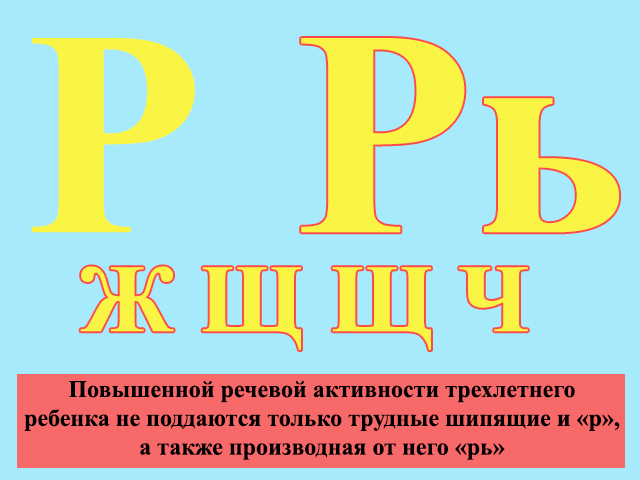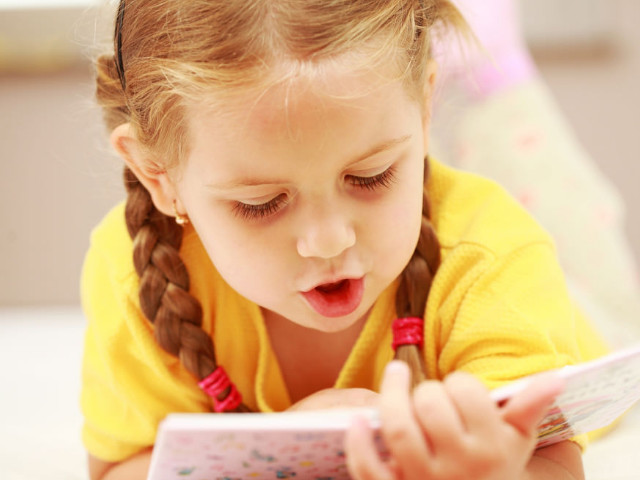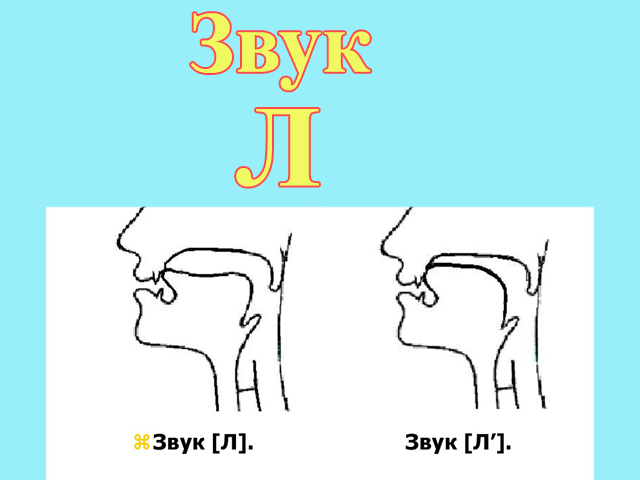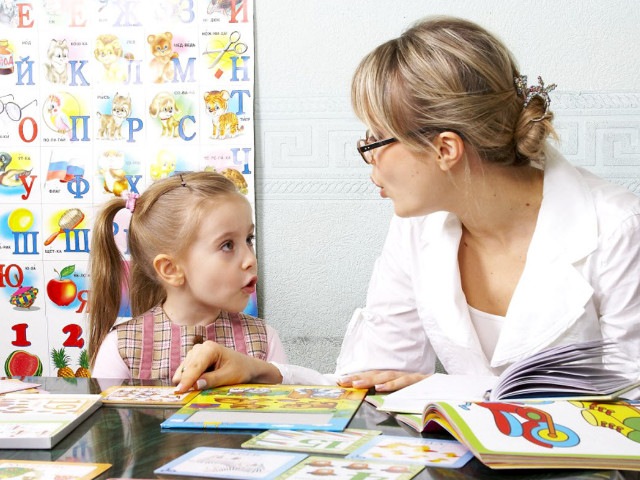How to teach a child to pronounce the letter "l"

Competent, beautiful speech without defects is the key to socialization and successful development. When communicating, everyone pays attention to how the person speaks. If the speech is beautiful and “flows like a stream”, it is pleasant to listen to such a person. In childhood, it is necessary to correctly resolve the speech of the child. The main problems and difficulties are the consonants "l" and "r".
The pronunciation of "l" seems simple to an adult, however, it can only be delivered by the age of 6 in some cases. This article will help you follow the rules when it comes to setting a hard and soft sound "l" in a child.
Preschool is an important period for everyone. Up to this point, babies learn to walk, talk, understand the world around them and themselves. Some consonants are difficult to pronounce and form over time. It is worse when parents do not pay attention to speech defects in a child. In adulthood, it is already very difficult to eliminate them, therefore, in all kindergartens, speech therapists work with kids in a group and individually.
The most common difficult-to-pronounce consonants are "l" and "r". Of course, with the moment of growing up, problems can go away without outside help, and sometimes not. The work of speech therapists is to help put the correct pronunciation in a preschooler. The sound "l" is both soft and hard. Sometimes a baby cannot pronounce any one kind, but more often children have problems pronouncing “l” in both cases.
Mispronunciation of sounds
Each period is characterized by the appearance of new sounds. By the age of three, babies should already pronounce all the letters except for difficult hissing and “r”, a derivative of “r” from it. At this age, children have increased speech activity.

By the age of five or six, the baby should pronounce all the sounds and express his thoughts not in simple sentences, but use complex turns. This age refers to the period of growing up and transition to school age. If a child has difficulty pronunciation, then you should seek help from a doctor or work hard at home.
The most common audio errors:
- hissing ones are replaced by the sound “sh”, “z”, (sorokh-rustle, hay-puppy, e-hedgehog);
- r are replaced by "l", "l" (work-work, steering wheel-lul, slavery-ladost).
What is lambdacism and paralambdacism
The incorrect pronunciation of the sound "l", "l" or its complete absence has a scientific name - lambdacism. It is divided into 4 types:
- nasal. The sound coming out with a stream of air tends to get through the nose, not through the mouth. This happens when the root of the tongue rests on the palate, obstructing the passage. In such cases, instead of "l", it turns out "ng pa-ngapa, lak-ngak;
- bilabial. The child puts his lips in a tube, in such a way that instead of the put “l”, it turns out “y”: a healer-healer, a uampa lamp;
- interdental. The tip of the tongue falls into the space between the teeth, showing the wrong sound;
- absence of "l". One of the most common choices. The kid does not pronounce "l" at all, instead, words are obtained without it: Look-uk, lens-inza.

What is lambdacism is now clear, but what then is paralambdacism. This includes replacing "l" with other sounds. These replacements include:
- replacing “l” with the sound “v” or “b”: lala - woman, lava-vava, moon-vuna;
- replacing "l" with "g": goal-gog, table-stack;
- replacing "l" with "d": horse-doshad, magnifying glass-dupa;
- replacing “l” with “ya”, “yo”, “yu”: lader-yager, spoon-hedgehog, onion-yuk;
- replacing "l" with a soft "l": business-delivery.
Reasons for the incorrect pronunciation of "l"
Mispronunciation of L occurs for certain reasons. These reasons include:
- a preschooler, due to his small age, cannot yet pronounce this sound. This defect is natural up to 4 years. At the age of 4-5 years, the baby should already know how to learn how to pronounce the letter “l”, and by the age of 6 he should distinguish between hard and soft “l” in words;
- weak muscles of the tongue and lower lip. Language performs the main function in the production of speech. If the child has problems with weak tongue muscles, then instead of "l" "v" will be heard;
- violation of phonemic perception of sound in the flow of speech. This effect is typical when the baby pronounces "l", and at this moment puts the tongue between the teeth. Bilabial pronunciation also belongs to this option, when the tongue is adjacent to the lower jaw and interferes with the correct pronunciation of sounds.

Such causes are often not associated with any defects in development. The problem is due to the wrong position of the tongue, or the wrong distribution of the exhaust air.
If a preschooler has difficulty pronouncing the “l” sound, this is easy to fix. It will take time to set it up. Usually 15-20 minutes a day at home, and after a while the child will succeed. If after a long period of time the efforts were in vain, you need to contact a speech therapist. .
Formation of the correct pronunciation of sounds
If the child does not suffer from diseases, pathological developments of the speech apparatus, then adults can quickly solve the problem. To understand how to put the sound "l" at home, you should follow a few simple rules.
- Work should begin with the strengthening of articulatory motor skills. Its strengthening is achieved through exercises and games.
- The next step is setting up the sound. The methods for this are different. There is a method for every case.
- Sound setting flows into pronunciation. When the student has learned to pronounce a letter, one must move on to syllables, and then to simple words, sentences with many repetitive sounds.
- Let's move on to more difficult work. We learn rhymes, tongue twisters. A preschooler will quickly learn sounds, develop memory.
- The results should be consolidated through telling and repeating fairy tales, stories, poems, stories, singing songs.
These simple rules should be given very little time per day. A peculiar curriculum is easier to transform into a game. The process will not be boring. You and your child will be passionate about business, not tedious work.
How to fix the sound "l"
The very first thing to start work with is to tell and show the student the correct pronunciation of the sound, and how the tongue and lips behave at the same time. To do this, there are many free photos and videos in the public domain online. Many methodological works have been developed on how to teach a child to say the letter "l". To put "l", you need to work on breathing and articulation.
At home, you yourself will be able to explain how to pronounce this or that sound correctly. Just think about how you do it, and then show. Children always learn the material better by the example of others. Just show the principle, let the baby repeat after you.
The problem of staging speech in children is a common thing. Lessons will help the child develop auditory perception of the sound "l".
It is important to breathe correctly and position the tongue and lips. Breathing exercises are designed as a game.

The simplest exercises will be of interest to the baby. Funny fun on the street can be instructive. While walking, you can play with dandelions, offering to blow off all his “feathers”, blow soap bubbles.
At home, you can play with a lit candle, blowing it out, or with a match, but only under the strict supervision of adults, and various similar games for blowing air. Such games will interest your baby and will be educational at the same time.
It is necessary to develop the child's fine motor skills of the hands. It is necessary for the correction of speech, intellectual and physical development.
Articulation "l"
First you need to work on the articulation of the language. The tip of the tongue should be pressed against the upper teeth and shaped like a hammock. Air leaks along the tongue. This position should be shown to the child by example, so the kids learn better. This is the first thing required in the initial work.
Mistakes when trying to pronounce "l"
In the work on the production of the sound "l" in a child, some errors may be identified. In this case, training attempts may fail.
Reasons for not being able to pronounce "l":
- incorrect position of the lips;
- the tongue is not located near the upper teeth, but goes into the inside of the mouth;
- improper exhalation of air - with the help of the cheeks or through the nose.

To get the correct pronunciation of "l", you should use articulation gymnastics.
Articulation gymnastics
Articulation gymnastics is the main method when setting "l". The average duration of classes should be 15-25 minutes, it all depends on the age of the baby. It should be based on various elements in stages in order for the child to be interested. It consists of several stages.
- Tasks for the development of speech breathing.
- Exercises to automate pronunciation.
Articulation gymnastics training
The most effective and efficient speech therapy exercises for the sound “l”: “Steamboat”, “Turkey”, “Horse”, “Wind”. Let us consider in more detail how each exercise is mechanically arranged.
"Steamboat". It is aimed at ensuring that the student learns to control the muscles of the tongue. The kid should smile a little and open his mouth, stick out his tongue about halfway, bite it and sing the repeated “Y-y-y-s”. The result is an imitation of a steamship whistle. If you hear a different sound, check the location of the child's tongue.

"Turkey". The mouth is ajar, the bent tongue is placed on the upper lip, the movement is made up and down the lip. We quickly exhale the air, we get a sound reminiscent of the “talk” of a turkey.
"Horse". The first is to teach a preschooler to click like a horse. The lower jaw must be immobile. The tongue rests on the sky, a slight smile, a slightly parted mouth. The next stage is to utter a clatter, but already without a voice and volume, silently. This is how the jaw muscles are developed.
"Breeze". We imitate the breath of the breeze. It should not come out along the central part, but along the edges. To do this, a novice student needs to bite the tip of the tongue and release the air. You can check the correct execution with a cotton swab. Bring it to your mouth and you will see the direction of the jet.

Solid "l"
If the child can pronounce the soft "l", then the hard one is a little more difficult for him due to the fact that the position of the tongue requires him to occupy the upper position. Usually in such cases there is no sound at all or is replaced by others.
To raise the tongue up, there are several exercises that also strengthen the muscles of the tongue.
- "The tongue is sleeping." The tongue is immobile between the teeth. The child is given the task to linger and continuously repeat “a”, after a while the baby is given the task to periodically bite the tip of the tongue, it turns out “al”.
- Another exercise for a hard “l” is to sing “s”, but already biting a wide tongue.
After that, we ask you to pronounce words with a different arrangement of “l” in words. The sound "l" at the beginning of the word: puddle, ski, fly, flying, burst, laser, bark, light bulb, lion, fox, pour, burst. In the middle of the word: class, eyes, analysis. At the end of the word: table, glass.
The next stage is the pronunciation of rhymes, tongue twisters, where a hard “l” is often found.
Automation
A number of articulation exercises performed require consolidation and constant pronunciation. If the child does not yet know how to read, parents should pronounce the words themselves, and then ask their children to repeat. So the preschooler learns the spoken sounds better.
First, the syllables “l” are pronounced with vowels: l-a, l-o, l-i; then vice versa: o-l, a-l, i-l, e-l.
Then the full words are spoken. "L" is at the beginning, middle, end of the word, softened or hardened, next to other consonants, and so on.
We repeat and learn poems and tongue twisters. When working, all phrases and sentences must be pronounced slowly and clearly so that distortion does not occur. If the kid is wrong, go back to the beginning of the sentence and repeat everything again. Praise him, it will help him feel confident. Repeat everything several times.

Such simple rules should be followed in order to teach a child to pronounce the letter "l" on the machine.
Help speech therapist
Do not worry if a child under 5 years old does not pronounce one or more sounds well. However, if at a later age it is difficult for him to succeed in letters, first resort to self-correction. If your attempts are unsuccessful, then you should contact a specialist. A common mistake parents make is their own mispronunciation, slurred speech, speech defects, and so on.
There are other cases when the help of a speech therapist is needed:
- if the baby has problems with the speech apparatus (OHP, dysarthria);
- with neurological diseases;
- with mental illness.

In these cases, self-help can only harm, not benefit.
Conclusion
Speech is an important attribute of every business person. It must be corrected from childhood, when only these problems appear, more often after 5 years. You can resort to do-it-yourself home fixes. Open access on the Internet will provide you with various graphic pictures, drawings and video tutorials, teaching aids.
If your efforts are in vain, and the baby does not know how to pronounce the letter “l” by the age of 6-7, you need the help of speech therapists who can quickly put your child in a beautiful, correct speech and give general advice.
- Essay by a speech pathologist
- Defectologist-speech therapist: what kind of specialty, where to study
- Speech therapy massage for children at home
- Creation of a developing environment in a speech therapy room
- The development of fine motor skills of hands in preschool children
- Sound analysis of the word: what is it and how to do it correctly
- Kemerovo Savelyeva Elena Nikolaevna

 Live Journal
Live Journal Facebook
Facebook Twitter
Twitter